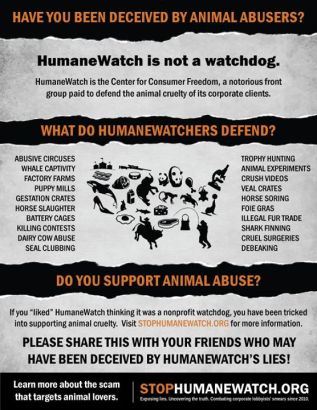 Written by: John Doppler Schiff and reprinted with permission
Written by: John Doppler Schiff and reprinted with permission
The HSUS is under attack by animal abusing industries. These industries claim the HSUS (Humane Society of the United States) is inefficient, ineffective, and incompetent.
But if this was true, why would animal abusers spend tens of millions of dollars annually on dishonest smear campaigns to attack the HSUS? If the HSUS was truly ineffective, wouldn’t animal abusers be perfectly happy to have such an incompetent opponent?
The truth is that the HSUS is the nation’s largest and most effective animal welfare organization, with a staggeringly long list of accomplishments — and animal abusers are terrified of what they’ve accomplished on behalf of the animals.
Here’s a small, incomplete sampling of what the HSUS does:
- HSUS donated $3000 to the first non-lethal deer population management program in Virginia.
- HSUS played a pivotal role in securing the defunding of horse slaughter for 2014.
- HSUS exposed Kenneth Schroeder, a “random source” dealer selling dogs to laboratories for cruel experiements. Schroeder’s license was subsequently revoked by the USDA.
- Two endangered tortoises were rescued and rehomed by the HSUS.
- Cheesecake Factory commenced the phase-out of gestation crates from its suppliers.
- Humane Society of Charlotte and the HSUS teamed up to rescue 23 dogs from a North Carolina puppy mill.
- Glee star Lea Michele and the HSUS ask NY legislature to regulate puppy mills more aggressively. In January of 2014, Gov. Cuomo signs the bill into law.
- An HSUS investigation exposed 116 Horse Protection Act citations assessed against the board of Tennessee’s Walking Horse Trainers Association.
- HSUS filed a formal complaint with the USDA demanding enforcement action against more than 50 commercial dog breeders operating illegally.
- Aubrey Organics joined the HSUS’ Be Cruelty Free campaign to end animal testing for cosmetics.
- Safeway pledged to eliminate gestation crates from its supply chain.
- HSUS launched a successful PSA campaign urging citizens to report animal abuse.
- HSUS provided the USDA with evidence of AWA violations by a research facility in Georgia, culminating in a $26,000 fine.
- HSUS investigation exposed disease, neglect, and cruelty at unregulated flea markets.
- Business Ethics Network bestowed two awards on the HSUS for its campaign to reform factory farm cruelty.
- HSUS successfully presented testimony to prevent the return of a puppy to the pet store owner who abused him.
- HSUS’ Duchess Sanctuary completed construction on a new hospital barn.
- HSUS reports exposed inhumane and unsafe conditions in three Maryland roadside zoos exhibiting dangerous exotic animals.
- Binghamton University joined the Meatless Monday campaign, with great success.
- HSUS warned consumers about falsely labeled “faux fur” garments containing rabbit fur, sold at Kohl’s.
- Infamous Chino slaughterhouse and Westland Meat Packing Co. slapped with $155,684,827.00 judgment — the largest animal cruelty penalty ever assessed — following HSUS investigation that revealed abuse of downer cattle at the facility.
- 40 dogs and 75 cats, miniature ponies, rabbits, and chickens rescued from NC pet mill.
- HSUS and Red Barn launch a leash and collar drive for pet owners in underserved communities.
- HSUS and Front Range Equine Rescue filed suits to block horse slaughter plants from opening.
- 31 dogs seized from dogfighting operations in Alabama thanks to a joint effort between law enforcement, HSUS, and local humane societies.
- Cracker Barrel shareholders voted to support the HSUS proposal to eliminate gestation crates from the company’s supply chain.
- Papa John’s pledged to eliminate gestation crates from its supply chain.
- Prop 204 passed in Arizona, eliminating veal and gestation crates.
- Prop 2 passed in CA, ensuring that poultry will not suffer in cages smaller than a sheet of letter sized paper their entire lives.
- 200 pit bulls rescued from the largest recorded dog fighting ring.
- 43 horses rescued from neglect in Lindale, TX.
- $600,000 grant from HSUS used to build a shelter in Jackson, LA.
- Animal Crush Video Prohibition Act of 2010 recriminalized crush videos.
- 5,700 fighting dogs and roosters rescued from animal fighting rings in 2009.
- Over forty emergency deployments for large-scale rescue of animals in 2009.
- More than 10,000 animals rescued in emergency deployments in 2009.
- 1800 tortoises saved from being buried alive in Florida construction.
- 1.8 million cows in California will NOT have their tails cruelly amputated without anesthetic this year thanks to the HSUS.

- 3,000+ puppies rescued from mass breeding facilities in 2009.
- 461 more pet stores agree to not sell puppy mill dogs in 2009.
- 50th reward paid for information leading to the arrest of animal fighting rings in 2009.
- 14 laws to protect wildlife passed in 2009.
- Cockfighting now illegal in all 50 states.
- 150+ retailers and fashion designers have agreed to go fur-free.
- Criminal abuse of cows at Conklin Dairy exposed and stopped.
- Chino slaughterhouse putting dying “downer” cattle into schools’ food supply, exposed and stopped.
- 8,057 animals treated for free in under-served areas in 2009.
- 4,300 homeowners advised on the humane removal of wildlife in 2009.
- 23,000+ low-cost spay and neuter surgeries in the Gulf Coast in 2009.
- 120 cats rescued from a hoarder in Tennessee in 2010.
- 40,000+ pets spayed and a quarter million dollars raised for spay/neuter programs during Spay Day 2009.
- 90 dogs rescued from a New Jersey puppy mill in 2010.
- 89 state laws protecting pets passed in 2009.
- HSUS sends relief personnel to Haiti for disaster assistance in 2009.
- 1300 animals have found refuge in HSUS’ Black Beauty Ranch.
- Maine phasing out cruel intensive confinement systems.
- Michigan phasing out cruel intensive confinement systems.
- 49 starving horses rescued in West Virginia in 2010.
- 8,320 animals treated by HSUS veterinarians in 2010.
- Kraft switched one million eggs to cage-free.
- Hellman’s adopted cage-free eggs.
- Subway phasing in cage-free eggs.
- Carnival Cruise Lines phasing in cage-free eggs.
- Royal Caribbean Cruise Lines phasing in cage-free eggs.
- Ohio’s agriculture industry agreed to phase out veal crates and gestation crates by 2015.
- HSUS transported 100+ dogs from overwhelmed Gulf Coast shelters to NJ and DC.
- HSUS holds Macy’s, Saks Fifth Avenue, and Bloomingdales accountable for mislabeling fur garments.
- 2000 pet rats rescued from a hoarder in Southern California.
- Truth in Fur Labeling Act signed into law.
- HSUS information leads to seizure of 100 roosters from a cockfight ring in Dallas, TX.
- Undercover video reveals horrific conditions at Smithfield Farms.
- HSUS distributes 30+ grants to equine rescues as part of American Competitive Trail Horse Association’s fundraiser.
- HSUS exposes Neiman Marcus sale of dog fur labeled as “raccoon”.
- D.C. Superior Court rules that Neiman Marcus violated the D.C. Consumer Protection Act by falsely labeling fur garments.
- Pepsi fans overwhelmingly vote to award HSUS a $250,000 grant to provide veterinary assistance to animals in underserved communities.
- After years of friction, the USDA agrees to appoint an ombudsman and improve oversight of the federal Humane Methods of Slaughter Act.
- 1,000th pet store joins HSUS’ Puppy Friendly Pet Store campaign, agreeing not to sell puppies.
- HSUS exposes sale of dog fur labeled as “fake fur” at Barney’s, in NY.
- Shark Conservation Act signed into law, prohibiting fishermen from cutting the fins off sharks and throwing them back into the water to die horribly.
- Ace of Cakes star Duff Goldman adopts cage-free egg policy.
- Federal Court of Appeals upholds an HSUS request to stop the slaughter of sea lions at Bonneville Dam on the Oregon/Washington border.
- HSUS exposes inhumane conditions at Willmar Poultry Company, the nation’s largest turkey hatchery.
- HSUS and Multnomah County Animal Services provide 40 animal crates to the American Red Cross’ Emergency Warming Center in Portland, OR.
- HSUS rescues 2500 rats as part of a hoarder intervention in San Jose, CA. The rescue was featured on Season Three of A&E’s documentary, “Hoarders”.
- On behalf of the Human Toxicology Project Consortium, HSUS coordinates a national symposium on modernizing the testing of chemicals in laboratories and reducing the role of animal testing.
- HSUS town hall in Lincoln, NE opens meaningful discussion of agricultural issues with Nebraska farmers.
- Wheaton, IL adopts non-lethal coyote deterrents instead of trapping and killing.
- HSUS investigation of Bushway Packing leads to conviction on charges of animal cruelty.
- 550 prairie dogs resettled, rescued from poisoning in Thunder Basin, WY.
- 14 turkeys find sanctuary at HSUS’ Black Beauty Ranch in TX.
 Photographer Robbie Bellon photographs 25 adopted and rescued dogs of 25 celebrities to benefit the HSUS’ Stop Puppy Mills Campaign.
Photographer Robbie Bellon photographs 25 adopted and rescued dogs of 25 celebrities to benefit the HSUS’ Stop Puppy Mills Campaign.- St. Vincent Hospital in Green Bay, WI switches to cage-free eggs.
- HSUS and the Kislak Family Fund present a $25,000 grant to the Florida College of Veterinary Medicine for a program to benefit injured and ill shelter animals.
- HSUS and Ellen Degeneres celebrate and raise awareness of shelters with the annual Shelter Appreciation Week, held the first week of each November.
- HSUS’ Cape Wildlife Center expands with the addition of a new animal hospital for wildlife rehabilitation.
- Prop 109, an anti-animal, anti-voter initiative, is defeated in Arizona.
- Fred Meyer Jewelers creates the Pawsitively Yours line of jewelry to benefit the HSUS’ Stop Puppy Mills Campaign.
- HSUS grants help Second Chance Animal Shelter of Brookfield, MA finish renovations after thieves steal building materials.
- HSUS’ Cape Wildlife Center releases a harrier back into the wild after 8 weeks of care and rehabilitation.
- The Coats for Cubs program repurposes old fur coats to aid and comfort wildlife.
- Wal-Mart’s private label eggs are now cage-free.
- HSUS helps persuade Sara Lee to switch to cage-free eggs.
- Orphaned raccoons raised and rehabilitated by HSUS’ Cape Wildlife Center are released into the wild.
- Medford, OR bakery, Harry & David, joins the growing cage-free movement.
- Humane Society Wildlife Land Trust establishes the Greenspring Wildlife Sanctuary, a permanent, protected, 154-acre wildlife habitat in Ashland, OR.
- Minnesota cat killer’s felony conviction on animal cruelty is upheld in State of Minnesota v. Ajalon Thomas Corcoran.
- Virgin America airlines switch to cage-free eggs.
- HSUS exposes the worst puppy mills in the “Missouri Dirty Dozen” report.
- HSUS teams up with the Florida Fish and Wildlife Conservation Commission, donating forensic investigation equipment to crack down on poaching.
- Valley Hospital of Ridgewood, NJ joins the national cage-free egg movement.
- Union Hospital of Cecil County, MD joins the national cage-free egg movement.
- St. Paul’s School of Concord, NH joins the national cage-free egg movement.
- Humane Society Wildlife Land Trust establishes a 30-acre permanent wildlife habitat, the Ogden Wildlife Sanctuary, in Leon County, TX.
- Pennsylvania joins the Interstate Wildlife Violator Compact, a nationwide law enforcement network of 36 states to prevent criminal poachers from hunting in other states.
- Pennsylvania signs HSUS-supported HB1859 into law, introducing felony penalties for poachers who are repeat offenders.
- HSUS transports 10 pit bulls rescued from Ohio fighting rings to the Washington Animal Rescue League.
- Barilla becomes the first pasta manufacturer to join the cage-free egg movement, switching 45% of its supply to cage-free in 2011.
- HSUS investigates and exposes bear baiting in South Carolina, the only state to tolerate this cruelty.
- Thanks to the efforts of HSUS, Animal Protection of New Mexico, Jane Goodall, Gov. Bill Richardson, and more, 186 chimpanzees were saved from further invasive medical testing in New Mexico.
- Florida Fish and Wildlife Commission votes unanimously to ban fox penning.
- HSUS rescued more than 90 dogs from a Montana hoarder.
- HSUS assisted in the rescue of 118 dogs from a breeder in Pascagoula, Mississippi.
- On behalf of local residents, HSUS took legal action against the Olivera Egg Ranch for noxious pollution emanating from that factory farm.
- HSUS and Blaze’s Tribute Equine Rescue took custody of 17 horses formerly destined for slaughter.
- HSVMA launched a petition urging Congress to phase out the non-therapeutic use of antibiotics in animal agriculture.
- Loyola Marymount University switched all eggs on campus to cage-free eggs
- 36 Pet Food Express stores took the “Puppy Friendly Pet Store” pledge.
- HSUS rescues 170 cats rescued from hoarders in Powell, WY; no reimbursement is requested for the capture, processing, treatment, and transport of the cats.
And that’s just a drop in the bucket.
Don’t fall for misinformation from the ignorant and the cruel.
Get the facts from a reputable source.

















